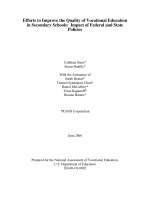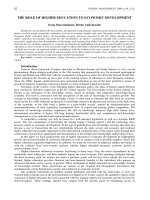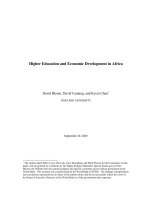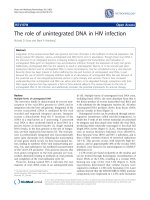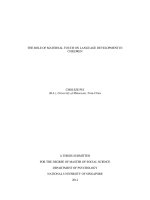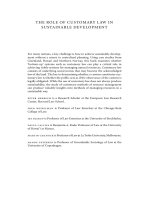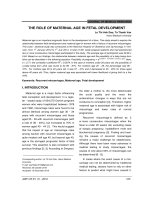The Role of Higher Education in Economic Development docx
Bạn đang xem bản rút gọn của tài liệu. Xem và tải ngay bản đầy đủ của tài liệu tại đây (62.68 KB, 12 trang )
The Role of Higher Education in Economic Development
Higher Education Alliance for the Rock River Region
Contributors
Northern Illinois University
Rockford College
Rock Valley College
University of Illinois College of Medicine at Rockford
Prepared by NIU Outreach
May, 2005
Executive Summary: The Role of Higher Education in Economic Development
The Role of Higher Education in Economic Development
Executive Summary
The HEARRR members – Northern Illinois University, Rockford College, Rock Valley College,
and the University of Illinois College of Medicine – have allocated fiscal, physical, and human
resources, and created entrepreneurship systems to advance economic development.
Major Trends in the Rock River Region
This area is undergoing demographic and industry changes that impact its economic development
and that relate directly to education.
• Population is projected to increase 9 percent from 2000 to 2010, with increasing
populations for those of Hispanic heritage and for those aged 55 to 64.
• Severe downsizing in the manufacturing sector meant the loss of 10,000 jobs.
• Jobs in manufacturing and other areas now typically require post-secondary education.
• Health services, construction, and logistics have strong growth projections and offer high
compensation per employee.
Ten Ways HEARRR Strengthens the Regional Economy
1. Raising educational levels to create a quality workforce by enrolling 18,000 students
annually in 64 certificate programs, 5 apprenticeship programs, 25 associate degree
programs, 80 bachelor’s degree programs, 11 master’s degree programs, 4 advanced nursing
degrees, a doctor of medicine degree, and a post-doctoral certificate in medicine
2. Improving learning and teaching from pre-school through graduate school through
working with the public schools and by securing over $10 million in competitive grants.
3. Training and supporting – where you need it, when you need it – over 1,000 businesses
and 4,000 employees each year, and through programs such as the Rock River
Entrepreneurship Center Network, Small Business Development Centers, and the
Procurement Technical Assistance program.
4. Providing lifelong learning opportunities to over 15,000 students a year through continuing
education, GED, adult basic education, and English as Second Language programs, as well as
the Jane Addams Center for Civic Public Engagement
5. Identifying the needs of business and industry by including them on nearly 80 advisory
committees for academic and professional programs.
6. Taking strong and visible roles in regional initiatives through partnerships that involve
hundreds of local public and private agencies.
7. Disseminating research and promoting technology transfer through over 25 specialized
research studies and by working with legislators to procure $6 million for the AgTech and
EIGERlab initiatives
8. Enhancing the technology infrastructure through NIUNet, a fiber optic network to give the
Rock River Region broadband access to the world, and by offering programs in information
technology, biotechnology, engineering, and applied technologies.
9. Promoting livable communities through extensive regional arts programming and NCAA
athletics.
10. Employing a diverse workforce with an annual payroll in excess of $66 million, which
generates an additional $24.8 million in income for Winnebago County alone.
The Role of Higher Education in Economic Development Page 3 of 12
Introduction
The role of higher education as a major driver of economic development is well
established, and this role will increase as further changes in technology, globalization,
and demographics impact the United States. To remain competitive in light of these
changes, regions will need to improve productivity and adopt an innovative spirit.
Higher education has the capacity, knowledge, and research necessary to help achieve
these goals (Sampson, 2003; 2004).
The focus of this report is the role of higher education in the economic development of Illinois’
Rock River Region. A brief summary of economic development issues in this region is given,
followed by a general discussion of the role of higher education in economic development and
specific actions taken by the institutions of the Higher Education Alliance for the Rock River
Region (HEARRR): Northern Illinois University, Rockford College, Rock Valley College, and
University of Illinois College of Medicine.
The Rock River Region
Rockford is the largest metropolitan area in the Northern Stateline Economic Development
Region and within Winnebago County, which accounts for three-fourths of the employment
within the region (NIU, May 2004). The area is undergoing demographic and industry changes
which impact its economic development and which relate directly to education.
Demographic Changes
From 2000 to 2010, the population of the region is projected to increase 9 percent. During this
same period, the population of those with a Hispanic origin is projected to increase 47 percent,
increasing the relative proportion of Hispanics in the total population from 7.4 percent to 10.1
percent (Woods & Poole, 2003). In 2000, 7.1 percent of the families in Winnebago County and
12.3 percent of the families in Boone County spoke Spanish in the home (NIU, 2004). Ways to
use this increasing diversity to enhance the economic development of the region need to be
explored.
From 2000 to 2010, the percent of the population age 55 to 64 is projected to increase 45.7
percent. The region needs to assess how, and whether, to replace these nearly 15,000 retirement-
age workers in the workforce (Woods & Poole, 2003).
Industry Changes
The Rock River Region is recognized as a leading national manufacturing center; however, from
1999 through 2003, the region lost 10,000 manufacturing jobs. Even though there is a 2.6 percent
projected decrease in manufacturing from 2000 to 2010, there are sub-sectors within
manufacturing with projected increases. These sub-sectors require advanced technical skills, and
dislocated workers need additional training to re-tool for these growth positions. For the
manufacturing sector, critical shortage occupations identified include CNC programmers, CNC
operators, machinists, and welders, all of which require postsecondary education and training
(NIU, May 2004).
The Role of Higher Education in Economic Development Page 4 of 12
Chart 1 reflects the relative strength of industry in terms of the projected growth from
2000 to 2010 and compensation per employee. The size of the circle depicts total
regional employment in that industry. As depicted in Chart 1, health services,
construction, and logistics not only have strong growth projections but also offer high
compensation per employee. The greatest need is for registered nurses; training for an entry-level
registered nurse position requires postsecondary education. Other examples of career growth
areas include speech pathology, occupational therapy, and physical therapy (NIU, May 2004).
Chart 1. Compensation per Employee by Industry
-10.00%
0.00%
10.00%
20.00%
30.00%
40.00%
$- $5,000.00 $10,000.00 $15,000.00 $20,000.00 $25,000.00 $30,000.00 $35,000.00 $40,000.00 $45,000.00 $50,000.00
Compensation per Employee
Growth rate 2000-2010
Health Services
Business
Services
A
utomobile
Ri
Educational
Services
Hotels and
Lodging
Social Services
Personal
Services
Recreation
Wholesale
Trade
Logistics
Retail Trade
Construction
High Growth
High Compensation
High Growth
Low Compensation
Low Growth
High Compensation
Low Growth
Low Compensation
Manufacturing
The critical challenge for the region is how best to provide strategically the workforce needed to
strengthen economic development. Historically, employees could earn sufficient wages with a
high school diploma or a two-year college degree, which is one reason why the region has a
baccalaureate completion rate lower than that of the state. With recent and anticipated
technological and industry changes, more positions will require some college education, and there
will be an ongoing need for continuing education. Raising the educational and skill levels of the
region is vital; however, this will not result in economic growth unless training is strategically
coordinated to meet current and potential industry needs and is accessible to all potential workers.
The Role of Higher Education in Economic Development Page 5 of 12
Higher Education’s Role
Higher education has historically included economic development as part of its core
mission. The colleges and universities serving the region have allocated fiscal, physical,
and human resources and created entrepreneurship systems within the institutions to advance
economic development. Senior administrators provide strong, visible leadership designed to
• create a quality workforce by growing, training, and attracting the finest talent
• support current business and industry
• improve learning and teaching from pre-school through graduate school
• take strong and visible roles in regional initiatives
• disseminate research and promote technology transfer
• enhance the technology infrastructure
• promote livable communities
• employ a diverse workforce
A Quality Workforce: Growing, Training, and Attracting the Finest
Higher education will be a dominant, if not decisive, factor in preparing workers with the robust
skills needed to adapt to changing job requirements. The transition from manufacturing to the
technology-based new economy dramatically raised the skill level needed to get a job. By 2005,
85 percent of all new jobs in America will require some level of higher education. The
requirements for current jobs are changing as well; from 1973 to 2003, the percent of workers age
30 to 59 with some postsecondary education increased from 28 to 60 percent, and nearly three-
fourths of the increase in the need for postsecondary education was due to “upskilling” –
employer demands for higher skills (Sampson, 2003; Sampson, 2004; Carnevale & Desrochers,
2003). In addition, higher education will be called upon to address the impending shortage of
college-trained workers needed to replace the baby boomers; by 2030, nearly 30 percent of the
workforce will be at or over the retirement age (Sampson, 2003).
Higher education prepares a quality workforce by offering instructional programs, matching
instruction to the needs of business and industry, and helping individuals learn throughout their
lives.
Instructional Programs
Teaching excellence is the key to a strong and growing regional economy (Sampson, 2004).
Higher education offers quality programs and services and continually improves these programs
to ensure teaching and learning excellence. Instructional programs can be traditional credit
programs or non-credit programs.
• The Alliance institutions offer a wide variety of credit instructional programming in the
Rockford area, including approximately 64 certificate programs, 5 apprenticeship
programs, 25 associate degree programs, 80 bachelor degree majors, 11 master degree
programs, 4 advanced nursing degrees, a professional program leading to a medical
degree, and a post-doctorate certificate in medicine.
• Over 18,000 students enroll annually in credit programs offered in Rockford by the
Alliance institutions. In the past two years, the annual enrollment in Rockford courses
increased 11 percent.
The Role of Higher Education in Economic Development Page 6 of 12
Identifying Needs of Business and Industry
Higher education connects workforce development to the economic development of the
region by matching instructional programs to the needs of business. Efforts include
working with business to identify specific needs, providing work-based learning oppor-
tunities for students, offering and supporting apprenticeship programs, and convening and being
responsive to advisory committees with representatives from business and industry. Once needs
are identified, higher education and industry work together to attract students into critical
programs.
• The members of the Alliance match instructional programs to the economic growth needs
of the region. In the past three years, they have completed over 35 assessments in various
labor market sectors to explore the need and feasibility of instructional programs.
• Numerous students complete internships, practicums, and student teaching in the Rock
River Region. The University of Illinois College of Medicine has a Family Practice
Residency Program and a College of Pharmacy Clerkship program.
• Over 80 advisory committees with representatives from business and industry provide
input into the programs offered by members of the Alliance.
Lifelong Learning of Individuals
Higher education helps individuals achieve their potential. “Just as ‘no child should be left
behind’ in getting a good education, … no worker should be left behind in having the skills
necessary to find a good job in the 21
st
century workplace” (Sampson, 2002, p. 3). Higher
education offers lifelong learning opportunities to individuals in these ways:
• Over 15,000 students take non-credit courses for personal development each year.
Courses are available to upgrade work skills, meet professional licensing requirements,
change jobs and careers, as well as programs for learning in retirement and for children.
• An average of over 700 dislocated workers utilized training and/or employment services
at Alliance institutions over the past three years.
• Members of the alliance coordinate and network with social agencies to help the low-
income and low-skilled workers through programs such as NIU’s $320,000 grant for
Rockford Concord Commons and Rockford College’s Jane Addams Center for Civic
Public Engagement.
• Alliance institutions provide support programs for special and minority populations, such
as disability services and programs for at-risk youth.
• Over 500 students enroll in GED and adult basic education courses offered by members
of the Alliance to improve their basic skills. Rock Valley College and Rockford College
have programs dedicated to English as a Second Language instruction.
• The Alliance institutions provide career services to help workers navigate an uncertain
career path, such as the career and college fairs, financial aid outreach programs, and
student ambassador program of Rock Valley College.
• Students from the alliance institutions serve as student teachers, interns, and consultants
for institutions in the region.
The Role of Higher Education in Economic Development Page 7 of 12
Support to Current Business and Industry
Current business and industry receives support through the customized services offered
by higher education. As technology and the economic climate change, higher education
can be a valuable resource to businesses in these ways:
• identifying employee skills gaps and providing customized training
• conducting organizational assessments and providing management development
• providing technical assistance, industrial liaison programs, and support centers
• assisting in the identification of new markets for products
• offering specialized help for small-to-medium sized businesses for planning, resource
acquisition, and marketing, e.g., entrepreneurship training and assistance
• providing customized research and data
• procuring grants which support current business and industry
• providing conference and meeting facilities
Examples of Alliance member support for current business and industry include:
• Members of the Alliance provide customized training and services to businesses.
Annually, over 100 businesses and 4,000 employees participate in these programs.
• The Illinois Manufacturing Extension Center, housed at NIU Rockford, provides
assistance in engineering, technical needs, information technology and marketing support
for small- and medium-sized businesses. Annually, over 75 businesses use this service.
• Rock River Valley Entrepreneurship Center Network, Small Business Development
Centers, and the Procurement Technical Assistance program serve 800 clients annually.
• Health Systems Research provides an array of reports for hospitals, health departments,
and government agencies, one of which resulted in “three share” health insurance.
• Each of the Alliance institutions offers meeting space, with high-quality conference
planning and hosting available. Specialized theatre and musical performance space is
available as well.
Learning and Teaching from Pre-school through Graduate School
Higher educational institutions work with P-12 schools to help prepare students with the
increasingly higher-level skills needed to obtain and retain employment. Preparing sufficient
numbers of students will be challenging, because there is a perceived “mismatch between the jobs
and careers of the new economy and the current core high school curricula and pedagogy”
(Carnevale & Desrochers, 2003, p. v). Together, higher education and P-12 school districts can
create a pipeline of workers by doing the following:
• emphasizing the importance of rigorous course work
• aligning P-16 curricula to the new economic skill sets
• providing career information
• coordinating work-focused training, including Tech Prep and Perkins programs
• establishing articulation agreements to provide seamless instruction
• identifying ways to increase the value placed on education within the region
The Role of Higher Education in Economic Development Page 8 of 12
Examples of P-20 initiatives of the Alliance institutions include the following:
• Over the past five years, the Alliance institutions have obtained over $10 million
dollars dedicated to improving P-20 education in this region. Their faculty and
staff are working directly with the schools. Grants are aimed at improving the quality of
education and the pool of future teachers, with a special emphasis on bilingual education.
• Over 1,000 high school students each year receive college-level credit at one of the
Alliance institutions through dual credit, Tech Prep, high school honors, and other
programs.
• The U of I College of Medicine and Rock Valley College are active in recruiting youth
for health careers.
• English as a Second Language programs are offered by Rockford College, Rock Valley
College, and NIU.
• Rockford College, through Public Agenda, provides a forum for discussions on
improving public education.
Strong and Visible Roles in Regional Initiatives
Efforts to enhance economic growth are shifting from tax-based incentives to attract businesses to
strategies that develop industry clusters designed to increase regional competitiveness and wealth.
The success of the industry clusters depends on the region’s science and technology capacity;
ability to develop global markets; availability of lifelong learning and training for employers and
employees; and collaborative relationships among research, capital, business, and public policy
(Ganzglass et al., 2003). Higher education, with its networks and linkages throughout the region
and state, is uniquely positioned to convene the necessary representatives from the diverse
government, business, education, social, and civic groups and to serve as the third-party, neutral
catalyst to create the collaborations needed to develop industry clusters.
The Alliance institutions are highly involved in regional initiatives, as noted below:
• The members of the Alliance are integrally involved with workforce initiatives, such as
Economic Development Council, Rockford Health Council, City of Rockford steering
committees, Rockford Area Economic Development Council, Greater Rockford Chamber
of Commerce, and other chambers of commerce in the region.
• Special projects with the Workforce Investment Boards identified critical skill shortages
and areas of potential economic development.
• The Alliance institutions are involved with the Rockford Area Arts Council, Illinois
Articulation Initiative, Career Education Association of North Central Illinois, Illinois
Community College On-line initiative, international study consortiums, and La Voz
Latina.
• The University of Illinois College of Medicine collaborates with the Winnebago Health
Department, Black Health Care Coalition, National Center for Rural Health Professions,
Rural medical Education Program, Project EXPORT, Northern Illinois Area Health
The Role of Higher Education in Economic Development Page 9 of 12
Education Center, the WHO Collaborating Center, and provides healthcare in
three rural centers.
• Participation in the R.I.C.E. initiative led to the RVC-NIU Partnership.
Research and Technology Transfer
Research and practical, application-based technology are needed to create sustainable economic
growth. Research conducted by higher education enhances the economic development of a
region in various ways:
• conducting economic and social research, including community audits, community
forums, and leadership briefings, used to identify assets; gaps in the economic, social,
and cultural infrastructure; critical skill shortages; growth opportunities; and trends in the
economic climate of the region
• facilitating technology transfer of basic and applied research which results in the design,
development, production, and commercialization of new or improved products, services,
or processes, with the ultimate outcome of creating new industries, capital ventures, and
jobs
• forming research partnerships with business which result in new technologies, industries,
and jobs
Examples of support for research and technology transfer by the members include the following:
• Over 25 specialized research studies are completed annually to address issues within the
Rock River Region, including Regional Economic Index Charts, Northwest Illinois
Market Facts
, and Health Systems Research.
• NIU, working with Congressman Don Manzullo, procured $1.5 million for the Belvidere-
Boone AgTech Initiative.
• Members of the Alliance are partners in the Building Manufacturing Capacity initiative
and were instrumental in securing $5.5 million for research that will take place at
EigerLab.
• Other projects, which involve the transfer of knowledge, include the Center for Systems
Security and Information Assurance, the Jane Addams Center for Civic Engagement, the
Public Agenda, the Northern Illinois Center for Non Profit Excellence, Pierce Programs,
Project EXPORT, and the National Center for Rural Health Professions.
Enhance the Technology Infrastructure
Higher education can be a technology driver and instrumental in raising the economic
development of the region by doing the following:
• designing cutting-edge technologies which result in new products, businesses, and jobs
• supplying advanced technology for use by the region
• providing technology instruction to create a skilled workforce
• addressing the digital divide for targeted areas and populations
• creating e-learning and innovative delivery to expand access to education
The Role of Higher Education in Economic Development Page 10 of 12
Examples of support for enhancing the technology infrastructure by Alliance institutions
include the following:
• In addition to certificate, associate degree, baccalaureate, and master degree programs
in information technology, biotechnology, engineering, and applied technologies, the
Alliance institutions look for ways to increase the region’s information literacy through
programs with the Northwest Community Center, on-line credit and non-credit courses,
and other e-learning initiatives.
• NIU and RVC are working together to be one of three nanotechnology educations centers
in the United States.
• NIU is developing NIUNet, a fiber optic network that will connect to RockNet and give
the Rock River Region broadband access to the world.
Livable Communities
Livable communities are viewed as great places to live and work. Higher education institutions
provide instruction and training, but they also provide arts, entertainment, sports, and recreation
programs that attract and retain a quality workforce. Professional-quality events are available to
the public free or at reasonable costs.
• The members of the Alliance add a breadth and depth to regional arts through programs
such as Rockford College’s Performing Arts Series, Art Gallery, Common Destinies
Series, Inside Rockford College Film and Speaker Series, annual Phi Beta Kappa
Speaker, and Forum Lecture Series; Rock Valley College’s Bengt Sjostrom Theatre,
Studio Theatre, Annual Shakespeare Festival, Summer Starlight Theatre Program,
community chorale, chamber singers, orchestra, jazz band, old-time band, and various
lecture series; and NIU’s and Rockford College Music Academy student and faculty
performances and participation in the Rockford Symphony and other musical groups and
theater; and NIU performances and exhibitions in all of the fine arts. Joint faculty
collaborations between NIU Community School of the Arts and the Rockford College
Music Academy are ongoing.
• Public Radio stations WNIU and WNIJ serve the region from NIU. Selected
administrators, faculty, and staff at each of the Alliance institutions provide consultation,
press comments, expert commentary, and interviews.
• There are 13 men’s and women’s NCAA Division III teams as well as 7 sports
represented in the North Central Community Conference of the NJCAA. Athletic events
provide entertainment for the region.
• Members of the Alliance sponsor study abroad trips to more than a dozen countries in
Europe, Latin America, Africa, and Asia and present hundreds of cultural performances
each year.
• Research conducted by Alliance institutions improved public schools, museums, libraries,
parks, housing, mental health, wellness, and drug prevention efforts.
The Role of Higher Education in Economic Development Page 11 of 12
• Healthy living is promoted through the Golden Eagles fitness program and
the CHIP program.
• RVC Dental Hygiene Clinic provides affordable and accessible dental care
to the community.
Higher Education as Employer
The role of higher education as a major employer of a diverse pool of workers cannot be ignored.
As a basic, revenue-generating industry, higher education directly, and through related
multipliers, impacts the economy of the region.
• The Alliance institutions in Rockford have an annual payroll in excess of $66 million,
which generates an additional $24.8 million income in Winnebago County.
Summary
The region faces many economic challenges and opportunities; whether it barely survives or
thrives depends upon the region’s ability to identify long-term, collaborative strategies that will
create a strong, versatile economy. The region has tremendous work ahead, and there are no
quick fixes if the underlying economic infrastructure is to be strengthened.
The loss of 10,000 manufacturing jobs was a massive blow to the economy; however, the
challenge is not only how to replace the jobs but how to create a workforce with the skills needed
for the new economy. No longer will a high school diploma be sufficient to obtain a good paying
position. Healthcare, the area of greatest projected growth, is built on highly trained workers with
postsecondary degrees. Manufacturing will still be a major part of the economy of the region, but
the jobs require advanced technology training.
To create the educational infrastructure needed to support a thriving economy, all sectors, private
and public, need to adopt a shared commitment to increase the value placed on education and to
improve the educational programs so there is a continuous pipeline of students who graduate from
high school with the requisite skills to succeed in postsecondary education. A high school
curriculum designed for students who might have been employed immediately after graduation in
the 1990s does not develop the skills and knowledge needed by workers in the new economy or
postsecondary students today.
The HEARRR institutions serving the region offer a myriad of programs and services and have
had a significant, continuing impact on the economic development of the region. Together, the
institutions of higher education invite the public and private sectors, including business and
industry, education, civic groups, not-for-profits, governments, and all citizens, to join them in
working together to leverage the resources of the region. Their primary task is to create a long-
term, sustainable economy based on seamless educational programs, a strategic physical
infrastructure, and livable communities that will attract and retain high quality workers.
For more information, contact Penny Billman, Ph.D., at NIU Outreach, via e-mail at
or at (815) 753-0928.
The Role of Higher Education in Economic Development Page 12 of 12
Bibliography
Carnevale, A.P. and Desrochers, D.M. 2003. Standards for What? The Economic Roots
of K-16 Reform. Princeton, NJ: ETS.
Ganzglass, E., Simon, M., Masseo, C., & Conlin, K. 2003. A Governor’s Guide to Creating a
21
st
-Century Workforce. Washington, D.C.: National Governors Association.
Northern Illinois University, May 2004. Northern Stateline Economic Development Region:
Critical Skills Shortage Report Manufacturing Industry. DeKalb, IL: NIU Outreach, Center
for Governmental Studies.
Northern Illinois University, 2004. Kids Count Data. DeKalb, IL: NIU Outreach.
Pappas, J.P. and Eckart, C.M. 1997. “Strategies for the Future: Continuing Higher Education and
Economic Development,” New Directions for Higher Education, 97(3), 96-101.
Sampson, D. June 10, 2002. Remarks for Economic Development EDA Denver Regional
Forum. Denver, CO.
Sampson, D. March 4, 2003. Remarks for the National Association of Workforce Boards.
Washington, D.C.
Sampson, D. November 12, 2003. Remarks for the National Association of State Universities
and Land-Grant Colleges. New Orleans, LA.
Sampson, D. June 10, 2004. Remarks for the National Coalition for Advanced Manufacturing.
Washington, D.C.
Woods and Poole Economics, Inc. 2003. County Projections to 2025. Washington, D.C.: Woods
& Poole Economics, Inc.
